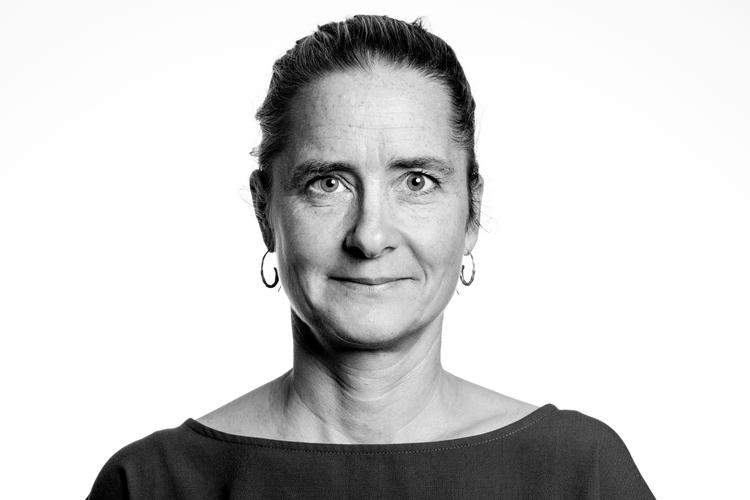
A memorial to one of the 63 young people killed in a 1998 disco fire in Sweden
By Line Vaaben
Much of my shaping as a journalist traces back 25 years, when I covered a deadly fire in Sweden. But it wasn’t until I returned to the scene a quarter-century later that I realized how the original story lingers in my mind — and in my body.* * *
The rocky hulk of Ramberget rises 282 feet (87 meters) from the island of Hisingen in Sweden, providing a stunning view of the town of Gothenburg below. On a September day in 2023 I was seated on a bench atop Ramberget, doing an interview. It was a chilly, windy day; the drizzle smeared my notes. But I hardly noticed. Nor did the man sitting next to me.
Rozbeh Aslanian was 44 when we talked last fall. But in the story he told, he was 19. That’s when he survived a devastating fire at a teenage disco in Gothenburg, only a mile from where we were sitting. Four hundred young people were at the party, and 63 of them died in the fire. One of them was Aslanian’s best friend.
All these years later, Aslanian remained tormented by survivor’s guilt. Only minutes before the dance floor exploded in flames, his friend had said he wanted to leave — but Rozbeh convinced him to stay. “It was my secret,” he told me. “But it became a poison eating me up from within.”
After years of trying to drown his guilt in alcohol, women and work, Rozbeh Asalanian decided to end his life. First, he had to one last thing: Tell his best friends’ parents the truth about that night.
Now he described how he was standing in the parents’ kitchen, telling them that he was responsible for their son’s death. He braced for shouts and screams in response. Instead, the mother embraced him and whispered in his ear: You didn’t start the fire. Remember that. You didn’t start the fire. It wasn’t you who killed him. You didn’t start the fire.
As Aslanian remembered that moment, he broke down. So did I. For a while I just held his hand. We sat, crying, in silence. Then he gathered himself and told the rest of his story.
‘… not about you.’
I have been a reporter for decades, and this is the first time I cried during an interview. Crying is something I always tell younger reporters not to do, reminding them: It is about the story, not about you. You can cry when you get home. Or after the interview when you transcribe your notes. It’s not that I don’t get moved by the stories I hear and the people I meet. But I pride myself on acting professionally, which always had meant keeping my own emotions in check.

Line Vaaben
Not this time. The tears ran down my cheeks and kept coming. I felt ashamed and apologized. But Aslanian just said, “I understand. You were there, too.”
He was right. Because 25 years ago I was there — not inside the gutted disco, but right outside.
It was the fall of 1998, I was an intern at the Danish national newspaper Berlingske. Late one night I was jolted awake by a phone call from a senior editor: “Get on a plane to Göteborg in Sweden, immediately.” I was told to report directly from the site. A few hours later I stood in front of the still-smoking building. The lights of firetrucks and police cars flashed around me. Dead bodies were piling up and distraught teens were gathering at the edge of the parking lot, trying to find out if their friends were dead or alive. I watched the ambulances leaving, some with survivors and some with dead bodies. The scent of the fire lingered in my hair for days.
The investigation determined that the fire was set by four teenage boys who hadn’t been admitted to the party. The young offenders were sentenced to three, six and eight years in prison. Four months later, I returned to Gothenberg and spoke with families, friends and first responders, interviews I captured in a longform narrative that families, a community and a country still smoldering with grief.
Exposure to trauma
In many ways the event set the path to my work as a journalist. I learned how important it is to report not only on tragic events, but also on the aftermath — on the human anguish and sometimes clarity that arise as people work through unthinkable levels of pain. Returning to the epicenter of tragedy gives one the opportunity to tell stories crucial both to victims and readers.
Fast forward to last summer, when I was lucky to be appointed as an Ochberg Fellow at The Dart Center for Journalism and Trauma at Columbia University. Each summer The Dart Center brings together a group of journalists for an intensive fellowship about how to report on traumatic events.
Many of us may think that only journalists in the field to cover war or major natural disasters are exposed to trauma. But research by Elena Newman, Ph.D. and professor of Psychology at University of Tulsa and Research Director of The Dart Center, suggest, that between 80 and 100% of journalists have been exposed to trauma through their work.
In my own career, I have immersed myself in stories about death and dying; I have witnessed a homicide autopsy, written a book about femicide and talked to people about suicide, rape and terminal diseases. Yet I never thought of myself as journalist who covered trauma, and certainly not as one who was affected by it.
At The Dart Center, I came to a much broader understanding of the field and learned a long list of new tools about approaching and interviewing sources who experienced trauma. I also came away with important knowledge about taking care of myself, before, during and after such reporting. I learned that self-care is a necessary part of your daily routine if you want to do this work without burning out.
Listening to and caring for yourself

Rozbeh Azlanian
After my fellowship, I returned to Sweden where I reconnected with some of the people I had met 25 years earlier: a mother who lost her daughter, a priest who opened his church to the grieving public, a fireman who tried to rescue youngsters from the fire — and the survivor, Rozbeh Aslanian. This time, I applied the lessons I had learned at Dart. The resulting story was published in Politiken on October 29, 2023 – exactly 25 years after the fire broke out. It is an immersion into how those involved dealt with the trauma back then, and how it has shaped their lives since. (Editor’s note: The link is to an English translation.)
It also taught me to pay attention to my own emotions. Bearing witness to catastrophe, fear, pain and loss lingers in your body. And after my experience with Rozbeh Asalanian, breaking down in tears at the top of that mountain above Gothenburg, I remembered the words of one of the professionals teaching at the fellowship. Dr. Kate Porterfield is a consulting psychologist at the Bellevue Program for Survivors of Torture. She told us how our body is wired to respond physically, psychologically and socially when we are under threat. And she also told us to stop and listen to it: “Your body will communicate with you. It will tell you what you need or needed to survive.”
So I listened to my body. And I realized that my reaction when interviewing Aslanian was not unprofessional or humiliating. I cried because I felt empathy with him for having carried a quarter-century of guilt. And for finally letting it go. But because, for once, I was part of the story. I was there that night, and the experience was lodged in my body.
I wish the same self-care for you. Here are some take-aways from my time at The Dart Center:
- Trauma journalism is not limited to wars and natural disaster. Being a journalist involves being exposed to numerous traumatic events, even on a daily beat covering local news: interviewing people who have lost relatives, covering a shooting or a car crash and talking to victims of violent assault. Journalists are craftsmen and trauma is part of the raw material we work with.
- Stop and listen. If you react during or after covering something traumatic or listening to account of trauma, pay attention and attend to it. Your body keeps a score, as the psychologist and author Dr. Bessel van der Kolk puts it. Reactions to reporting a difficult story can be physical, psychological and social. Notice whether you feel unusually tired, forgetful, irritable, are avoiding working on your story or avoiding the company of others.
- Don’t try to toughen up. The hardliner reporter who possesses a special psychological immunity is a cliché. We are human; exposure to trauma has an impact. Research shows that we undergo many of the same working conditions as other first responders: Doctors, emergency workers, police and firefighters. We should treat ourselves accordingly and learn from them.
- Practice self-care. After covering a stressful event you might feel like winding down with Netflix, comfort food and a glass of wine. But you may also consider other types of self-care on a daily basis that will help you keep you fit for the next event. List of suggestions: Yoga, mindfulness, climbing, running, biking or any other kind of physical activity; keeping an appreciation diary; spending time in nature, spending time with friends and family, or simply just taking time off after difficult assignments.
- There is no fixed guideline. Alhough there is research to lead the way, no fixed map shows you exactly how to report and react when covering trauma. We are all human and all different; our experiences and boundaries differ, too.
* * *
Line Vaaben is a writer and editor for Politiken, the largest newspaper in Denmark. Her work has been published in several Danish textbooks, and she teaches narrative and longform journalism to students and professionals.


